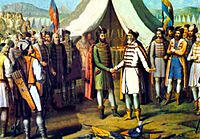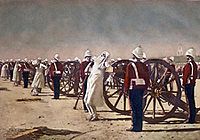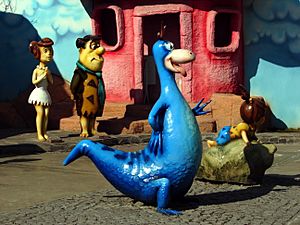Anachronism facts for kids

An anachronism is something that is out of place in time. The word comes from Greek words meaning "against" and "time." It's like seeing a dinosaur riding a bicycle – bicycles didn't exist when dinosaurs lived!
An anachronism can be an object, a way of speaking, a technology, or even an idea. It's anything that belongs to one time period but shows up in another.
Sometimes, anachronisms are put into stories or art on purpose. This might be to make a historical story easier for people today to understand. Other times, they are used for comedy or to make a point. Anachronisms can also happen by accident if a writer or artist doesn't know enough about a certain time period.
Contents
What are the different kinds of anachronisms?

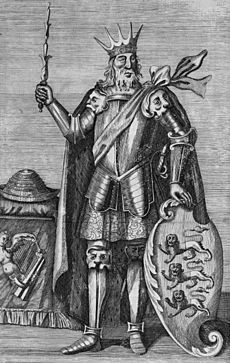
Parachronism
A parachronism is something that appears in a time period where it's not usually found. But it's not completely impossible for it to be there. Think of it as something that's just a bit out of place.
For example, an old-fashioned top hat might seem strange if someone wears it today. It's not impossible, but it's definitely from another time.
Prochronism
A prochronism is an anachronism that is impossible. This happens when an object or idea appears in a time period before it was invented. So, it simply could not have existed then.
An example would be a caveman using a smartphone. Smartphones didn't exist thousands of years ago, so this is impossible.
Behavioral and cultural anachronism
Sometimes, people choose to use old things or act in old ways. For instance, someone today might choose to write with a quill pen. This isn't an accident; it's a choice that reflects their style.
Anachronisms for a political message
Artists and writers sometimes use anachronisms to make a political point. They might show something as being older than it really is. This can make an idea or custom seem more important or traditional.
For example, a 19th-century Romanian painter, Constantin Lecca, showed leaders from the 1500s with flags that were only invented in the 1830s. He did this to support the idea of uniting different parts of Romania.
Anachronisms in art and stories
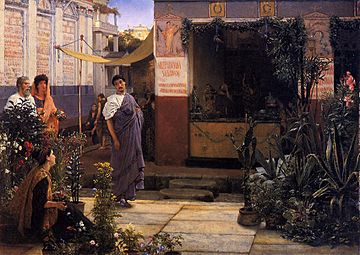
Anachronisms are often found in stories or movies that are set in the past. They can happen because the creator doesn't know all the historical details. Or, they can be put in on purpose.
Sometimes, writers use anachronisms to make a story more interesting for people today. But this can backfire! What seems modern to one generation might look outdated to the next. For example, a movie from the 1940s might show a historical character acting like someone from the 1940s. This might seem strange to us now.
Before the 1800s, people didn't worry much about historical accuracy. So, you can find many anachronisms in old paintings and plays by famous artists like Raphael and Shakespeare.
Comical anachronism
Sometimes, anachronisms are used to make people laugh. For example, a comedy show set in the Stone Age might show characters using modern gadgets. This can be very funny! It can also make a point about how society has changed or stayed the same.
Future anachronism
Even science fiction writers can accidentally create anachronisms. It's hard to predict the future! A story written years ago about the future might mention things that are now outdated. For instance, some old science fiction stories set in the future might talk about the Soviet Union, which no longer exists.
Also, futuristic technology might appear next to old technology. In some old sci-fi stories, characters might travel through space but still use slide rules for calculations, which are very old tools.
Language anachronism
Language changes quickly. In movies set in the past, characters often speak in a modern way. This is usually done on purpose. If they spoke exactly like people from the 15th century, most of us wouldn't understand them! So, filmmakers use modern language to make the story easier to follow.
Unintentional anachronisms
Sometimes, anachronisms happen without anyone meaning to. This can happen when people record history. They might accidentally add details from their own time period. For example, old records of medieval statues sometimes show them with beards, even though beards were rare in the Middle Ages. The people making the records were used to seeing beards in their own time.
Anachronisms in history studies
When historians study the past, they try to avoid anachronisms. It's a mistake to judge people and events from the past using today's ideas and values. This is sometimes called "presentism."
Good historians know that past societies were very different from ours. They try to understand history on its own terms, not by comparing it to today.
Finding forgeries with anachronisms
Spotting anachronisms can be a powerful tool to find out if an old document or object is fake. If something claims to be from a certain time, but it contains details that didn't exist then, it's probably a forgery.
Here are some examples:
- In 1440, a document called the "Donation of Constantine" was proven to be fake. It claimed to be from the 300s AD, but it mentioned the city of Constantinople. That city wasn't named Constantinople until 330 AD, after the document was supposedly written.
- The "William Lynch speech" was supposedly given in 1712. But it uses words like "program" and "refueling," which weren't used in that way until much later. This shows it's a 20th-century fake.
See Also
 In Spanish: Anacronismo para niños
In Spanish: Anacronismo para niños
- Anatopism
- Evolutionary anachronism
- Invented traditions
- List of stories set in a future now past
- Presentism
- Retrofuturism
- Skeuomorph
- Society for Creative Anachronism
- Steampunk
- Whig history


